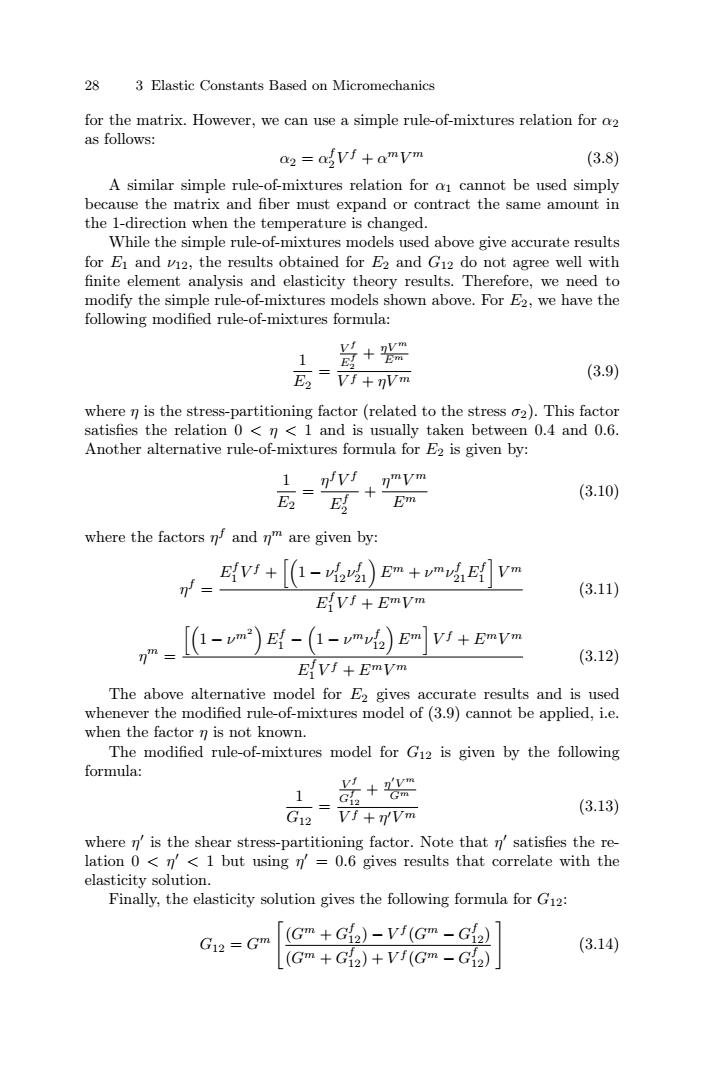正在加载图片...

28 3 Elastic Constants Based on Micromechanics for the matrix.However,we can use a simple rule-of-mixtures relation for a2 as follows: a2 agvf+amym (3.8) A similar simple rule-of-mixtures relation for o1 cannot be used simply because the matrix and fiber must expand or contract the same amount in the 1-direction when the temperature is changed. While the simple rule-of-mixtures models used above give accurate results for E and v12,the results obtained for E2 and Gi2 do not agree well with finite element analysis and elasticity theory results.Therefore,we need to modify the simple rule-of-mixtures models shown above.For E2,we have the following modified rule-of-mixtures formula: + Vf 1 Vf+nvm (3.9) where n is the stress-partitioning factor (related to the stress o2).This factor satisfies the relation 0<n<1 and is usually taken between 0.4 and 0.6. Another alternative rule-of-mixtures formula for E2 is given by: 1 nvf nmym EE以 +Em (3.10) where the factors n and nm are given by: Ev时+[1-以)Em+m以E]vm (3.11) ElV/+Emvm [(-vm)E-(1-wm)EmVJ+Emvm (3.12) ElV+Emvm The above alternative model for E2 gives accurate results and is used whenever the modified rule-of-mixtures model of(3.9)cannot be applied,i.e. when the factor n is not known. The modified rule-of-mixtures model for G12 is given by the following formula: vf 1 + G12 VI+nVm (3.13) where n'is the shear stress-partitioning factor.Note that n'satisfies the re- lation 0<n<1 but using n=0.6 gives results that correlate with the elasticity solution. Finally,the elasticity solution gives the following formula for Gi2: G12=Gm (Gm+G2)-V时(Gm-G2) (3.14) (Gm+Gi2)+V5(Gm-Gf2)28 3 Elastic Constants Based on Micromechanics for the matrix. However, we can use a simple rule-of-mixtures relation for α2 as follows: α2 = αf 2V f + αmV m (3.8) A similar simple rule-of-mixtures relation for α1 cannot be used simply because the matrix and fiber must expand or contract the same amount in the 1-direction when the temperature is changed. While the simple rule-of-mixtures models used above give accurate results for E1 and ν12, the results obtained for E2 and G12 do not agree well with finite element analysis and elasticity theory results. Therefore, we need to modify the simple rule-of-mixtures models shown above. For E2, we have the following modified rule-of-mixtures formula: 1 E2 = V f Ef 2 + ηV m Em V f + ηV m (3.9) where η is the stress-partitioning factor (related to the stress σ2). This factor satisfies the relation 0 <η< 1 and is usually taken between 0.4 and 0.6. Another alternative rule-of-mixtures formula for E2 is given by: 1 E2 = ηfV f Ef 2 + ηmV m Em (3.10) where the factors ηf and ηm are given by: ηf = Ef 1 V f + 1 − νf 12νf 21 Em + νmνf 21Ef 1 V m Ef 1 V f + EmV m (3.11) ηm = 1 − νm2 Ef 1 − 1 − νmνf 12 Em V f + EmV m Ef 1 V f + EmV m (3.12) The above alternative model for E2 gives accurate results and is used whenever the modified rule-of-mixtures model of (3.9) cannot be applied, i.e. when the factor η is not known. The modified rule-of-mixtures model for G12 is given by the following formula: 1 G12 = V f Gf 12 + η V m Gm V f + η V m (3.13) where η is the shear stress-partitioning factor. Note that η satisfies the relation 0 < η < 1 but using η = 0.6 gives results that correlate with the elasticity solution. Finally, the elasticity solution gives the following formula for G12: G12 = Gm (Gm + Gf 12) − V f (Gm − Gf 12) (Gm + Gf 12) + V f (Gm − Gf 12) (3.14)